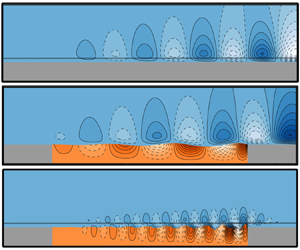Article contents
Global stability and resolvent analyses of laminar boundary-layer flow interacting with viscoelastic patches
Published online by Cambridge University Press: 22 February 2022
Abstract

The attenuation of two-dimensional boundary-layer instabilities by a finite-length, viscoelastic patch is investigated by means of global linear stability theory. First, the modal stability properties of the coupled problem are assessed, revealing unstable fluid-elastic travelling-wave flutter modes. Second, the Tollmien–Schlichting instabilities over a rigid wall are characterised via the analysis of the fluid resolvent operator in order to determine a baseline for the fluid-structural analysis. To investigate the effect of the elastic patch on the growth of these flow instabilities, we first consider the linear frequency response of the coupled fluid-elastic system to the dominant rigid-wall forcing modes. In the frequency range of Tollmien–Schlichting waves, the energetic flow amplification is clearly reduced. However, an amplification is observed for higher frequencies, associated with travelling-wave flutter. This increased complexity requires the analysis of the coupled fluid-structural resolvent operator; the optimal, coupled, resolvent modes confirm the attenuation of the Tollmien–Schlichting instabilities, while also being able to capture the amplification at the higher frequencies. Finally, a decomposition of the fluid-structural response is proposed to reveal the wave cancellation mechanism responsible for the attenuation of the Tollmien–Schlichting waves. The viscoelastic patch, excited by the incoming rigid-wall wave, provokes a fluid-elastic wave that is out-of-phase with the former, thus reducing its amplitude.
- Type
- JFM Papers
- Information
- Copyright
- © The Author(s), 2022. Published by Cambridge University Press
References
REFERENCES
- 5
- Cited by





